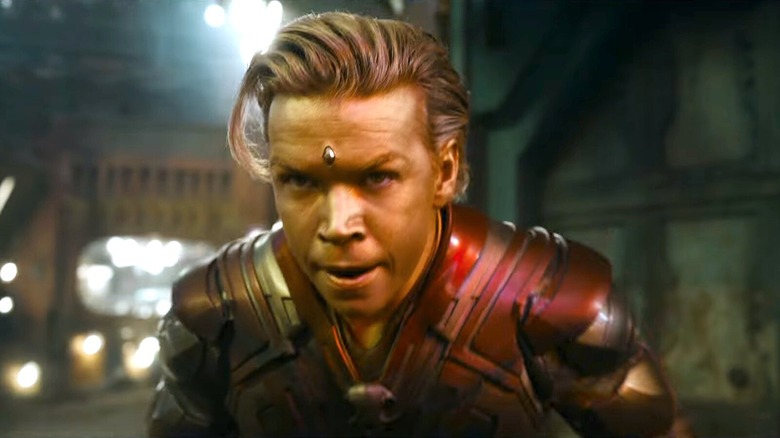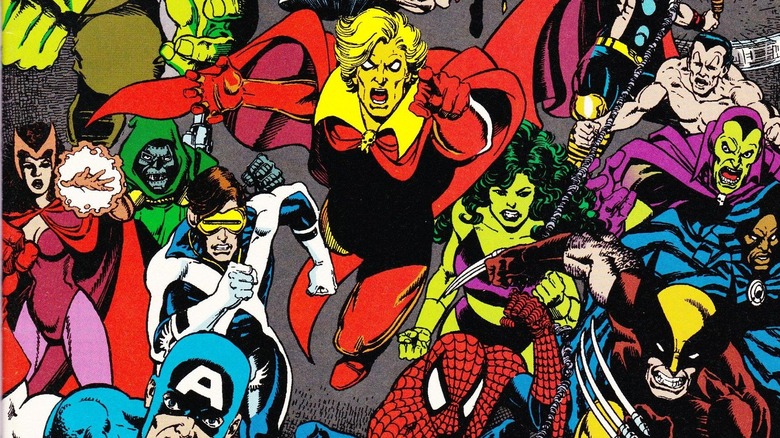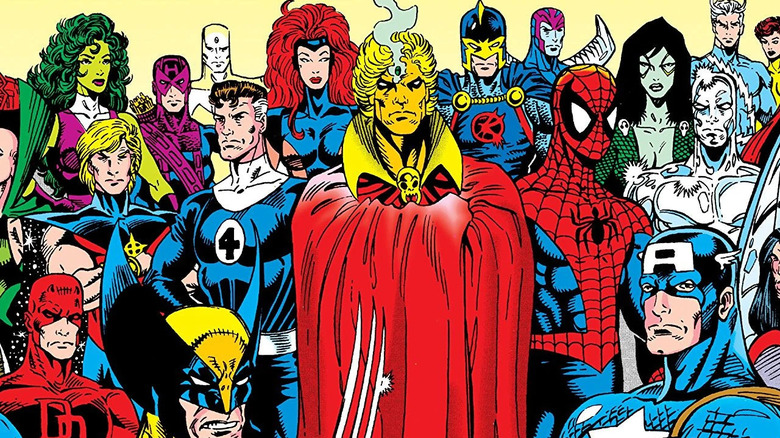
Minor spoilers for "Guardians of the Galaxy Vol. 3" follow.
At the beginning of James Gunn's "Guardians of the Galaxy, Vol. 3," the 32nd film in the Marvel Cinematic Universe, the title characters are going about their daily lives, listening to pop music, when a mysterious glowing gold alien (Will Poulter) appears in space. As he flies toward their home -- an enclosed space outpost called Knowwhere -- Heart's "Barracuda" plays on the soundtrack.
Sharp-eyed MCU aficionados will likely recognize this character as a member of Sovereign, a species of genetically engineered, impeccably regal aliens that like to tout their own perfection. In a post-credits stinger in "Guardians of the Galaxy, Vol. 2," the Sovereign High Priestess Ayesha (Elizabeth Debicki) was seen tending to a large, mechanical cocoon. She said that she was creating the most powerful Sovereign yet, and intends to name him Adam.
The newly-hatched Adam, nicknamed The Warlock, will serve as an antagonist in "Vol. 3." Adam's goal is to retrieve something for his boss' boss, the film's true villain. While upright and regal, he remains clueless about the world throughout the film; he is only a few months old, after all.
Fans of Marvel Comics know this character as Adam Warlock, a moody, space-bound superhero created by Stan Lee and Jack Kirby in 1967, and then again by Roy Thomas and Gil Keane in 1972. Adam Warlock has actually played a major role in several Marvel Comics events, and was once part of a team called the Infinity Watch, who took care of the Infinity Stones after Thanos lost them.
Him

In the comic books, Adam Warlock was -- like in the "Vol. 2" stinger -- grown in a cocoon with the intention of creating a "perfect" being, only on the page, he was created on Earth by a team of human scientists. Only called "Him," this early version of Warlock fought with Thor and then fled into space to find himself. It wouldn't be until Him ran into a supervillain called the High Evolutionary that he would be re-named Warlock. The High Evolutionary also gave him the Soul Gem, one of the six Infinity Gems (renamed Stones for the MCU). Over-powered, possessed of a God complex, and armed with the ability to steal people's souls, Adam Warlock idly drifted through the cosmos, contemplating his own fate and having ethereal, existentialist conversations with his rivals and foes.
Adam Warlock was a cerebral character, and his adventures were often of a weird and spiritual nature. His arch-enemy, for instance, was the Magus, his own evil twin. The Magus was nothing more than a future version of himself, corrupted by using the Soul Gem too much. Adam Warlock traveled into the future by a few minutes and stole his own soul to prevent himself from becoming the Magus. Heavy stuff.
Along the way, Adam Warlock would befriend a few characters that would later be repurposed into members of the Guardians of the Galaxy. Warlock was beloved by Gamora and fought alongside Drax the Destroyer. He also was friends with Pip the Troll, a character who appeared in a post-credits stinger after "Eternals." Because of their association, it's fitting that Adam Warlock should eventually appear in a film version of "Guardians of the Galaxy."
Adam would die when Pip, Gamora, and he are sucked into the Soul Gem themselves.
The Infinity Saga

Anthony and Joe Russo's 2018 film "Avengers: Infinity War" was about Thanos (Josh Brolin) and his quest to find the six Infinity Stones, so that he may wipe out half the population of the universe. In the movies, Thanos was concerned about overpopulation. He achieved his goal at the end of the movie. In the comics, in a 1991 event miniseries called "The Infinity Gauntlet," Thanos was a more philosophical character who worshipped death and adhered to nihilism. In order to please Death, a physical character he was in love with, he wiped out half the universe right at the beginning of the story. The rest of the story was about the unification of the remaining heroes in their futile attempt to take Thanos down. They fail miserably and are all killed. Spider-Man has his head staved in with a rock. Wolverine is turned into rubber. Iron Man's head is ripped off. Readers called it "heavy metal awesome." Well, maybe not "readers," but I did.
The superhero charge is led by none other than a resurrected Adam Warlock, who had escaped from the Soul Gem with Pip and Gamora in tow. He and Thanos knew each other in the past, so it was fitting they face off. At the end of "The Infinity Gauntlet," Adam Warlock would end up in possession of the six Infinity Gems. None of Earth's heroes were responsible enough to wield them. Thanos retired to a farm, devoted now to peace and life rather than the worship of Death. Adam, now essentially God, fled into the stars.
Frankly, it's a better story than the one seen in the movies, which ended in a mere conflagration.
The Infinity War

After the events of "The Infinity Gauntlet," a collection of deities (called "cosmic beings" in Marvel lore) judged that Adam Warlock was also not responsible enough to wield the six Infinity Gems, and he was forced to distribute them to a collection of guardians. Gamore was given the Time Gem, Drax was given the Power Gem, and Pip the Troll was given the Space Gem. Adam kept the Soul Gem for himself, as he had used it in the past. The Mind Gem was given to a character named Moondragon, as yet unseen in the MCU, and the Reality Gem was given to a newly humbled Thanos. "Warlock and the Infinity Watch" which ran from 1992 to 1995. It was this author's favorite comic book.
Warlock's stories were most often written by prolific comic book author Jim Starlin, who most often wrote Marvel Comics' headier, "cosmic" stories. Warlock was aloof, emotionally cold, and always contemplative. He would brawl as well as any comic book superhero, but he was not a hothead or a bruiser. Adam Warlock was convinced of his own superiority because, well, he was created to be superior. This lent to many excellent character conflicts with his teammates whom he always deemed to be lesser-than. He was a Superman, but in the Nietzschean sense, calmly confident in his abilities and the power of his mind. Eventually, he ejected both "good" and "evil" out of his soul, making him truly Beyond Good and Evil.
The cinematic version of Adam Warlock possesses the aloof, distant qualities of his on-page counterpart, but, as director James Gunn likes to do, he is transformed into a lighter, more comedic character. He's still fun, but he's a new Warlock for a new generation.
Read this next: The Most Powerful MCU Villains Ranked
The post The History of Adam Warlock in the Marvel Universe appeared first on /Film.
0 Comments